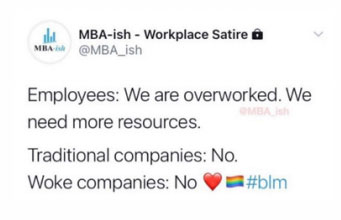Not very long ago, my Instagram played out a now-familiar narrative. I opened my feed to find it flooded with an endless stream of little black tiles. Indian companies, Bollywood stars, one obscure Danish fashion brand – all with the same little black square with the same hashtag – #BlackoutTuesday in support of Black Lives Matter.
Digital natives across the world reacted swiftly. Instagram’s comments’ section was bursting with the same demand – “a black tile is fine, but what are you actually doing to promote on-ground change?” Several Bollywood personalities were trolled for their performative support of Black Lives Matter when they have fronted fairness cream campaigns. The Danish fashion brand was asked how many BIPOC they have in their team (spoiler alert: the answer was “none”).
In the days following, there was a simultaneous hush and cacophony on Instagram. Brands went silent whilst their comments’ sections continued to burst with demands of accountability. Ironically, most brands had probably never experienced such high engagement rates in their digital histories.
Around a fortnight after the black tile pantomime played out, I opened my Instagram feed to suddenly find it flooded with an endless rotation of aesthetically designed, PR-team-approved apologies. “We can do better.” “We are sorry.” “We will change.” “We recognise our privilege.” In this episode of fighting for an equitable world, it was fashionable for brands to “take accountability.” Vague statements that pandered to a public demand for change – without truly committing to anything tangible.Once again, the Instagram REDIFFUSION INDIA | TALK TO US comments’ section – that new frontier of activism, particularly in the time of social distancing – collectively rolled its eyes. “Sure, sure. Thanks for the empty words. What are you actually doing?
”When the answer to that question wasn’t satisfactory, or the question was completely ignored altogether, there was a mass exodus of followers. People consciously choosing to NOT think about Brand X or Celeb Y any longer because they had made the cardinal error of pandering. With a barrage of pithy comments and face-palm emojis, digital natives have killed one of advertising’s most enduring recent trends – The Purpose.
I have been in the industry for long enough to have worked on many a purpose in my time. And for most of these purposes, the end goal was a hero film that led to a few shed tears on the other side of the TV screen. Digital natives – those Gen Z kids who commandeer presidential rallies through TikTok whilst dressing like they’re Spice Girls – have had enough. They are the generation of Malala, Amika, and Greta. They’ve had enough of our empty pandering to public sentiment and our appropriation of topical issues for a little more social media engagement. generation of Malala, Amika, and Greta. They’ve had enough of our empty pandering to public sentiment and our appropriation of topical issues for a little more social media engagement.
They call us out on whitewashing.
On greenwashing.
On pinkwashing.
On rainbowwashing.
On non-intersectional feminism.
On performative allyship.

They are growing into one of the most financially powerful generations – globally they’re expected to account for $140 billion worth of spending this year alone. They are also more politically conscious, having grown up on a steady diet of political opinions and digital catfights. In India, roughly half of its Gen Z youth has taken part in online activism, and a third have protested IRL.
And as the first generation that has grown up with access to screens before they could speak, they are experts at seeing through coded language and vacant hashtags. Whilst I, as a Millennial on the older end of the spectrum, may not have immediately noticed the nothingness of Brand X’s “we’re sorry” post, Zoomers were already flooding their comments with sharply crafted jabs designed to leave their social media and PR teams shame-faced.
“Brand purpose” just isn’t enough anymore. As sellers, if we want to truly turn this world-changing generation into loyal customers, we have to not only say we stand for something, but completely redesign our corporate policies and culture to be in line with our purpose.They’re the generation that has lived through two massive economic recessions and a pandemic before they hit 25. And they are the generation that feels the crushing pressure to fix our mistakes with their conscious living choices.
No longer is purpose enough without action. Their money goes only to brands that align with their values. It’s time to turn purpose into more than just a tear-jerking TVC and a slogan to proudly print on our T-shirts to be worn at corporate events. It’s time to turn purpose into a culture of corporate activism. Not only because it’s the right thing to do, but because it’s good for business too.

